My Pandemic Diary, Entry #60
Hello Fellow City Cooks,
It’s Friday and a beautiful start of a holiday weekend in the big city. I’m thinking of taking Sunday off from writing this diary, just to give myself a holiday of my own – a day without a schedule. So if I don’t visit your inbox, don’t worry. I’m fine.
I can’t help but think how back in the normal, I used to say that Fridays were my Saturdays, using that day in the historic sense because Saturdays used to be a day off for nearly everyone. For years, since I worked from home, I’d prefer to work on Saturdays and instead use Fridays to do my weekly errands, including all my grocery shopping. And it was also a day when maybe I’d meet a pal for lunch or else have a late afternoon date with my husband when we’d almost always end up at the Met.
But the mornings were mine to roam. I’d take my little red grocery cart and go from my neighborhood Greenmarket, to Whole Foods, then to Trader Joe’s, and maybe, after dropping all that off at home, I’d do a long walk to Zabar’s. Each place had its own special purpose.
In the summer, when all the seasonal farmers were back, the Greenmarket was where I’d get New Jersey tomatoes and peaches, amazing garlic and the most perfect lettuces from J&A Farms from upstate NY, and from the Dutchess County fruit farmer there would always be the peak of the season, starting with strawberries so perfumed that you’d smell them before you’d see them. Whole Foods was where I’d get most things, including meats and some fish but I’d also get a few very specific things at Trader Joe’s, like raspberries and nuts and smoked trout, but especially the tiny baby zucchini to which I had become addicted. I’d roast them for 20 minutes until tender and then dust with Parmesan. When I needed a special fish or meat, I’d shop at Citarella or the Hudson & Charles butcher shop. And Zabar’s was high church for cheese, olives, charcuterie, smoked fish, bread and coffee. I miss this carefree weekly ritual so very much and I think of it every Friday.
Nothing special coming up for this Memorial Day weekend. I have my usual ambitions -- to take walks, read, try to keep up with the housecleaning, watch more episodes of “Call My Agent,” stay in touch with friends, and maybe also come up with new ideas for meals instead of the usual repertoire which is getting a bit boring.
Cooking and Groceries
Last night’s dinner was a slow-roasted boneless lamb shoulder roast, Yukon Gold potatoes that cooked alongside the lamb, and asparagus. I bought the 1.8-pound lamb at Whole Foods already boned and tied but I untied it so to season it with a paste of garlic, rosemary, thyme, dried oregano, a pinch of red pepper flakes, salt, and olive oil (it all got pulsed in the food processor). Then I re-tied it with butcher’s twine, a kitchen tool I never used to have on hand but now can’t cook without it. I saved a bit of the garlic-herb paste and rubbed the outside of the roast before placing it into a roasting pan, surrounding it with two-inch pieces of potato and a drizzle of olive oil. Into a 275°F oven for two hours, and halfway through I poured about ½ cup of red wine into the pan. This recipe, by the way, is from my cookbook, now ten years old (!).
I cooked the asparagus simply -- trimming off the bottom of the stalks that were too coarse, submerging them in cool water in case there was any dirt in the tips, and boiling for about four minutes until tender. I didn’t add any other seasoning aside from a little olive oil and salt and pepper to the asparagus because I knew that the big flavors of the lamb and roasted potatoes would greet the asparagus on our dinner plates.
You may wonder why a less than two-pound roast took two hours to cook. And that is because it was a shoulder, not a leg of lamb. I mentioned yesterday that it’s very important, essential even, to know your cut of meat before you decide how to cook it because all cuts of meats are not the same.
Here’s why. Where on the animal’s body the cut comes from, significantly influences how it should be cooked, and in some cases, how it should be sliced. Meat is muscle and any muscle that has been heavily worked, like the ribs with constant movement in and out from breathing, or the shoulders that move all day as an animal walks as it grazes or feeds, or shanks around joints, will develop more ligaments and sinews and thus will need more time and lower heat to become tender.
The cuts that are from the most-used parts of the animal need to be cooked low and slow, like the low temperature multi-hour roasting I gave my lamb shoulder last night, or a long gentle braise, as when a piece of chuck is used in beef stew or pot roast. The ligaments and other connective tissue will thus be given a chance to dissolve, bringing the meat to a falling-off-the-bone state of tenderness.
The parts of the body that are less frequently used, like the loin or the main leg muscles, may be very lean or marbled with fat, but both will be without the same ligaments and structure. Care must be taken to not overcook these parts or else they will be dry and tasteless.
Depending on your palate and preferences, you may find the slow-cooked cuts to be more flavorful, which for me is the case with both lamb and beef; I think a lamb shoulder roast has much more personality than a leg of lamb, even if it takes twice as long to cook. Likewise, I love the lesser cuts of beef, like flank, skirt or hanger steaks far more than a filet mignon, and short ribs more than prime rib. Some of these tougher cuts can be cooked quickly, as with a flank steak, but you must then slice it against the grain or otherwise it will be too tough to chew.
The long-cooked cuts also tend to be less expensive, as if due to a kind of reverse correlation: if it takes more effort to cook, it costs less, but a filet mignon, cut from a tenderloin, which only needs a fast sear, is the most costly of all beef. This is not hard and fast because sometimes popularity is what drives the price, as with veal shanks, also called osso buco, which requires a long cook (in the eponymous classic Italian dish, it’s braised), but is very costly.
So what do you we need to know? First, know what you’re buying and appreciate that all cuts are not interchangeable; if you’ve headed to the market to buy lamb for a stew and there’s no shoulder, you may need to change your menu. A butcher’s pre-cut “lamb stew meat” is almost always from the leg for the simple reason that it’s easier for the butcher to cut and trim it. Always ask what the pre-cut stew meat is before you buy and if it’s from the leg, consider making kebabs instead of stew, or ask if the butcher has lamb shoulder (they can remove the bone) and cut it into your own pieces. For beef, stew meat is usually chuck, which is a very good choice, but you should still ask to make sure that this is what it is.
Second, if you’re buying from a butcher shop or good meat counter, the person serving you will probably know where on the animal’s body anything is from. So if you’re not sure what you’re buying and how how to cook it, just ask. A good butcher will not only know where from the animal the product is from, s/he will also have cooking tips, e.g., which is best to grill, which is best for stew, which is best to roast.
This may have been a long lesson, but there’s much to know. And food is too expensive and important to our health and pleasure to not have it be the best it can.
Pandemic Tips
I enjoyed last night’s NYT Cooking/YouTube Happy Hour with Yewande Komolafe more than the previous one and think that Yewande was delightful and very interesting. My only complaint, if it is one, is that instead of being a Happy Hour, what Sam is doing is conducting interviews. He’s a serious guy and a journalist, not a typical personality/host, and I really value that about him. Maybe they should just change the name of the thing which would change at least my expectation that it would be more interactive. In any case, I hope he and NYT Cooking keep these going.
It’s the start of the weekend and it’s a holiday one. Try to do something fun and optimistic for yourself.
Stay safe and have a nice dinner.
Kate McDonough

